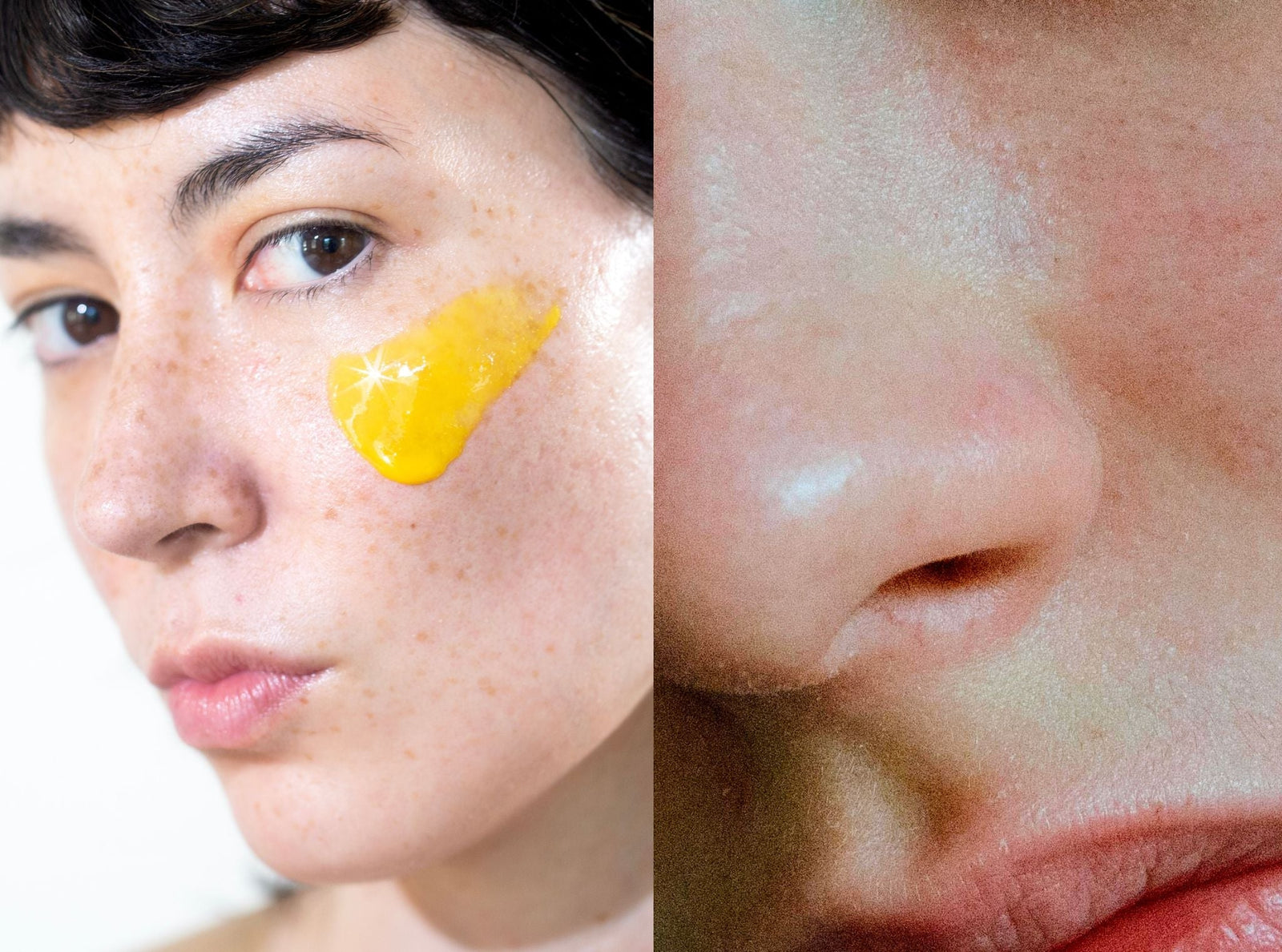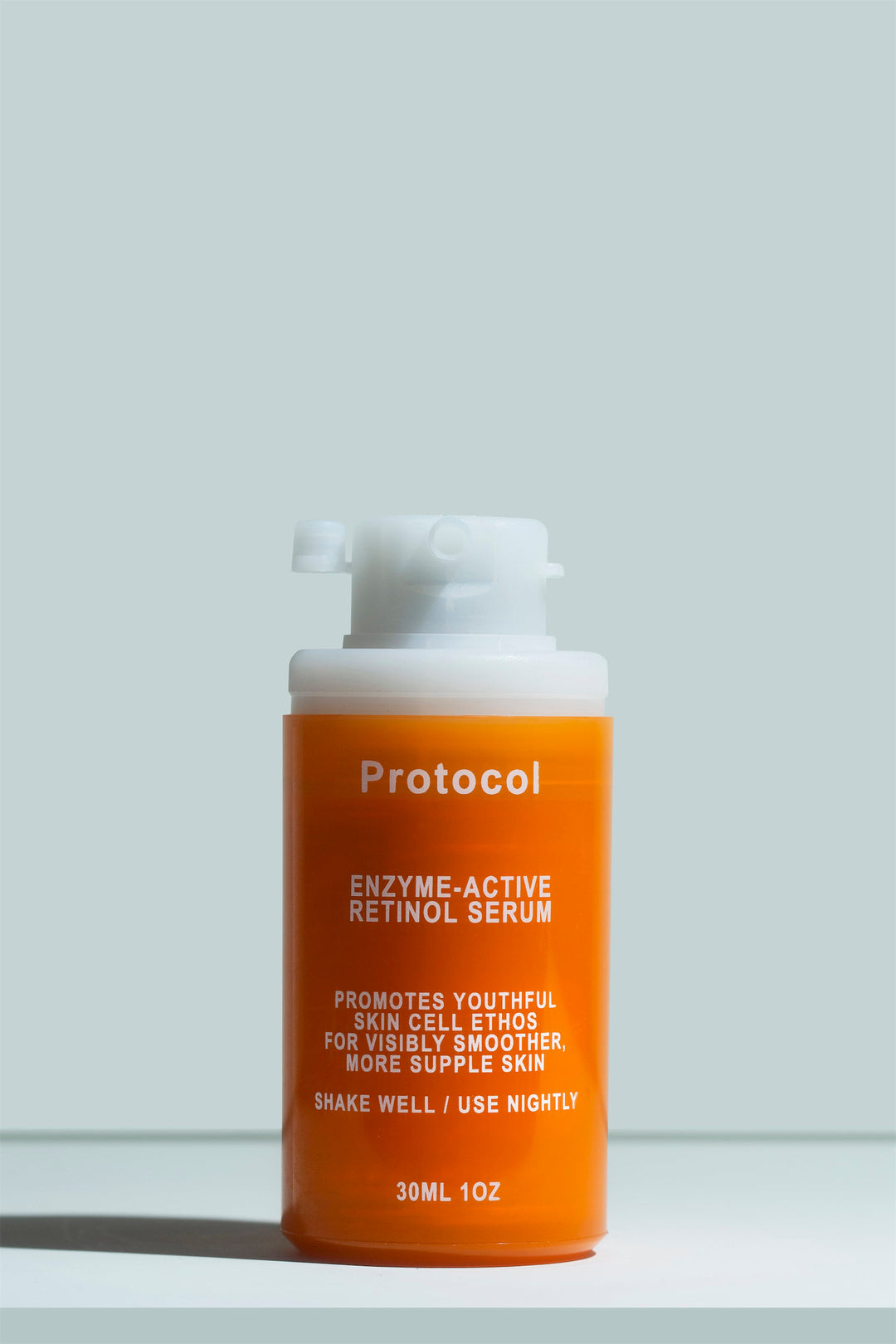Retinol and Rosacea: Are Retinoids OK If You Have Rosacea?

Trying new skincare can be frustrating when you’re dealing with an inflammatory skin condition. Should you use something as powerful as retinol when you have rosacea?
While some doctors caution against it, the dermatologists who are most tuned in to the cosmetic world understand that it can be quite beneficial sometimes. After all, just because you have rosacea doesn’t mean you don’t also want to enjoy the powerful anti-aging benefits of retinoids.
In this post, we’ll cover everything you need to know about retinol and rosacea, including tips on how to add retinol to your routine.
Understanding rosacea
Rosacea is a chronic inflammatory skin condition responsible for recurring symptoms often referred to as “rosacea flare-ups”.
The main symptoms of rosacea include recurring facial flushing, persistent redness, bumps or pimples, visible blood vessels, and rough or thickened skin. These symptoms usually occur in the center of the face, on the cheeks, nose, chin, and forehead.
Like many skin conditions, rosacea is multifactorial. Your genetics, immune system, overgrowth of Demodex mites (i.e., a type of skin microbiome imbalance), and even lifestyle can all be implicated in this chronic condition.
Anything that can cause stress or inflammation in the body can trigger the flare-ups themselves, including alcohol consumption, eating spicy food, mental stress, and more.
There are a few types of rosacea that differ by severity and how symptoms manifest. The two most common types are erythematotelangiectatic rosacea (this mouthful of a condition causes diffuse facial redness and visible capillaries) and papulopustular rosacea (which also causes acne-like bumps).
Understanding retinol
Retinol is the biggest anti-aging star in the skincare world and it’s undeniably our favorite active ingredient here at Protocol Labs. There’s a lot of research that shows that retinoids (i.e. the family of ingredients retinol belongs to) can transform the skin profoundly.
This family of vitamin A ingredients encourages faster, healthier skin renewa once they reach the skin and undergo a few conversions.
They help visibly reduce fine lines, skin texture, pore size, discoloration, and even breakouts by basically forcing the skin to behave more healthily.
At the same time, retinoids (especially retinoic acid, the most powerful form that is only available by prescription) can irritate the skin, especially at the early stages of use. In most cases, the skin learns to tolerate the retinoids and even becomes thicker and stronger over time.
Compared to other forms of vitamin A, retinol is quite mild and gentle but also has fairly minimal results. On the other end of the scale, retinoic acid (also known as tretinoin) is powerful with a higher chance of sensitizing the skin. Retinaldehyde, the next step from retinol and precursor to retinoic acid, strikes a balance. Also known as retinal, it offers results that are just as impressive as retinoic acid but with the gentleness of retinol (learn more in our comparison of retinol vs retinaldehyde).
Is retinol ok to use on rosacea?
Whether it’s okay to use retinol on rosacea depends on the circumstances, and the answer isn’t clear-cut.
Most dermatologists agree that if your skin is actively flaring up, you might be better off avoiding retinol and other retinoids. That’s because there’s potential for retinoids to irritate the skin and prolong the inflammation, especially if they’re new in your routine.
That said, the only retinoid that frequently irritates is tretinoin, and even that only happens in around 20% of users. There are even studies showing that retinoids can be beneficial for rosacea, helping to reduce redness and bumps with regular use.
To be clear, there’s not enough evidence to believe that retinoids should be the first line of treatment for rosacea. It’s enough to suggest that they aren’t necessarily harmful, and may even offer the benefits of taking the effort to introduce them correctly.
The science on retinol and rosacea
Right now, there’s not a lot of science on either the safety or benefits of using retinoids for rosacea.
The most robust studies have researched the use of retinoids to treat papulopustular rosacea (i.e., “acne rosacea,” which presents with acne-like bumps or pustules), often in combination with the antibiotic clindamycin. Interestingly, the researchers concluded that the combination seemed to help reduce the redness and visible veins more effectively than it did the acne-like bumps.
Interestingly, in 1999, researchers published a small study showing that after 5 months, retinaldehyde helped alleviate rosacea. About 75% of the patients with erythema (redness) showed improvement using a 0.05% formula. The researchers couldn’t pinpoint a single mechanism of action, although they pointed out a few possibilities, including retinal’s ability to improve epidermal thickness or its ability to help the skin shed Demodex mites.
No matter what kind of rosacea you have, researchers highlight the importance of choosing gentle retinoid formulas. In the case of prescriptions, this is usually done through microencapsulation, which slows and controls the way active ingredients impact the skin.
How to use retinol when you have rosacea

Have a solid basic routine in place
By the time you’re ready to start a cosmetic retinoid, you should already have a basic skincare routine that includes sunscreen, cleanser and moisturizer.
Developing a skincare routine for sensitive skin can feel like a game of whack-a-mole, but taking it slow and choosing fragrance-free ingredients will reduce your chances of flaring up.
Choose a gentle retinoid
Once you’re ready to introduce a retinoid to your routine, look for a gentle option that’s not likely to irritate the skin. Thankfully, this doesn’t mean you need to compromise on results.
With both retinol and retinaldehyde, the risk of skin irritation is quite low, but both are clinically backed by research showing that they can reduce the appearance of wrinkles, fine lines, hyperpigmentation, and skin texture in general.
Of the two, retinaldehyde is the more impressive ingredient. Its effects are comparable to those of prescription-strength retinoic acid but it is just as gentle on the skin as retinol.
Slow introduction
When you have rosacea, retinol and other powerful active ingredients should always be introduced gradually. That means that you shouldn’t use them daily right away. Instead, ease your skin into their skin-renewing power with twice-weekly use. Then, increase frequency to 3 or 4 times per week, until you find your sweet spot or work your way up to daily use.
Experiment with application techniques
With retinoids, the more directly they’re applied to your skin, the more potent they will be. In the case of a gentle formula like our Enzyme Active Retinol Serum, we always suggest trying it at full impact, which means applying it to damp skin.
For the majority of our clients, including those with rosacea, this application technique works without any issues.
However, if you are worried about irritation or you’re using a product like retinoic acid that has a higher risk of side effects, there are other options:
- You can “buffer” your retinoid, which means applying it after a hydrating serum or moisturizer.
- You can try “sandwiching” which means buffering with a moisturizer or serum, applying your retinoid, and then applying another layer of moisturizer or an occlusive balm.
Consider other treatments
Since rosacea is a complex condition, there are many different ways to treat it. From soothing topical serums that can help reduce redness to medications that can help with Demodex overgrowth, there are many options.
Most over-the-counter and cosmetic products are compatible with retinol (although perhaps not within the same application). If you’re already using a prescription rosacea treatment, ask your doctor before introducing a retinoid.
Pay attention to signs of irritation
As you start using retinol, pay close attention to your skin and especially to the early signs of a rosacea flare-up. The truth is that compared to sun exposure or diet or allergies the skincare products you use are quite unlikely to trigger a flare-up.
Even so, there is still some risk as you start using retinol in your skincare routine. If you notice the beginning of redness, flakiness, or bumps in the areas where you normally have a rosacea flare-up, either slow down or discontinue the use of your retinoid.
That said, keep in mind that a little bit of skin peeling is normal when starting to use a retinoid - the key is that it won’t trigger your rosacea.
FAQ
Is it OK to use tretinoin if you have rosacea?
If you have rosacea, it’s important you speak to your dermatologist before trying tretinoin. While there have been some successful studies showing that retinoids can be beneficial for reducing redness associated with rosacea, there is also a risk they will irritate the skin further.
What should you not use on your face if you have rosacea?
If you have rosacea, you should avoid using any products that are known triggers for you. People with rosacea are more likely to have allergic reactions to cosmetic ingredients, but the specific triggers will vary from person to person.
In the study, the ingredients found to be more likely to cause allergic reactions were metals, dyes, and preservatives that aren’t normally used in skincare. The only exception and ingredient you’ll have to pay close attention to is fragrances.
You may also want to avoid high levels of volatile alcohols like denatured alcohol or isopropyl alcohol, as they can be drying to the skin, as well as harsh abrasives or any products that sting your skin or leave it feeling sore or irritated.
Is azelaic acid or retinol better for rosacea?
Azelaic acid is generally considered the better option for rosacea. It’s available both as a cosmetic and as a topical treatment, offering very gentle skin renewal along with a soothing effect.
Try a rosacea-friendly retinoid
If you feel like your skin barrier is ready for it, you don’t have to wait - you can use retinol on rosacea. It’s just important to introduce it at a time when you’re not having flare-ups and to take it slow.
You’ll be able to benefit from retinol’s skin-smoothing and brightening effects. If your rosacea is quite bumpy, there’s even evidence retinoids could help bring down its redness. While it’s not the first thing we’d recommend when it comes to skincare for sensitive skin, it very well might be the fifth thing.
The Protocol Enzyme Active Retinol Serum delivers to the skin a unique retinoid called retinaldehyde. It’s one of the gentlest retinoids available, but its wrinkle-reduction and skin-renewing effects rival stronger Rx retinoids.




